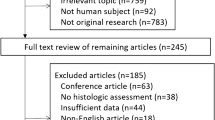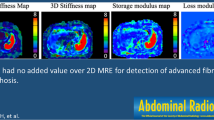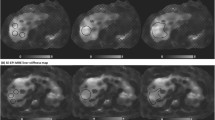Abstract
Objectives
To compare the diagnostic performance of gradient-recalled echo-based magnetic resonance elastography (GRE-MRE) and spin-echo echo-planar imaging-based MRE (SE-EPI-MRE) in liver fibrosis staging.
Methods
A systematic literature search was performed to identify studies involving the performance of MRE for the diagnosis of liver fibrosis. Pooled sensitivity, specificity, positive and negative likelihood ratios, the diagnostic odds ratio, and a summary receiver operating characteristic (ROC) curve were estimated by using a bivariate random effects model. Subgroup analyses were performed between different study characteristics.
Results
Twenty-six studies with a total of 3,200 patients were included in the meta-analysis. Pooled sensitivity and specificity of GRE-MRE and SE-EPI-MRE did not differ significantly. The area under the summary ROC curve for stage diagnosis of any (F ≥ 1), significant (F ≥ 2), advanced (F ≥ 3), and cirrhosis (F = 4) on GRE-MRE and SE-EPI-MRE were 0.93 versus 0.94, 0.95 versus 0.94, 0.94 versus 0.95, and 0.92 versus 0.93, respectively. Substantial heterogeneity was detected for both sequences.
Conclusion
Both GRE and SE-EPI-MRE show high sensitivity and specificity for detection of each stage of liver fibrosis, without significant differences. Magnetic resonance elastography (MRE) may be useful for noninvasive evaluation of liver fibrosis in chronic liver disease.
Key points
• Pooled sensitivity and specificity of GRE-MRE and SE-EPI-MRE did not differ significantly.
• GRE-MRE and SE-EPI-MRE were highly accurate for detecting all stages of fibrosis.
• Due to better agreement and repeatability, GRE-MRE should be used first.
• In case of failure on GRE-MRE, SE-EPI-MRE should be used.




Similar content being viewed by others
Abbreviations
- CLD:
-
Chronic liver disease
- MRE:
-
Magnetic resonance elastography
- GRE:
-
Gradient recalled echo
- SE-EPI:
-
Spin-echo echo-planar imaging
References
Tsochatzis EA, Bosch J, Burroughs AK (2014) Liver cirrhosis. Lancet 383:1749–1761
D'Amico G, Garcia-Tsao G, Pagliaro L (2006) Natural history and prognostic indicators of survival in cirrhosis: a systematic review of 118 studies. J Hepatol 44:217–231
Martínez SM, Crespo G, Navasa M, Forns X (2011) Noninvasive assessment of liver fibrosis. Hepatology 53:325–335
Venkatesh SK, Yin M, Ehman RL (2013) Magnetic resonance elastography of liver: technique, analysis, and clinical applications. J Magn Reson Imaging 37:544–555
Castera L (2012) Noninvasive methods to assess liver disease in patients with hepatitis B or C. Gastroenterology 142:1293-1302.e1294
Hagiwara M, Rusinek H, Lee VS, Losada M, Bannan MA, Krinsky GA et al (2008) Advanced liver fibrosis: diagnosis with 3D whole-liver perfusion MR imaging--initial experience. Radiology 246:926–934
Friedrich-Rust M, Muller C, Winckler A, Kriener S, Herrmann E, Holtmeier J et al (2010) Assessment of liver fibrosis and steatosis in PBC with FibroScan, MRI, MR-spectroscopy, and serum markers. J Clin Gastroenterol 44:58–65
Loomba R, Wolfson T, Ang B, Hooker J, Behling C, Peterson M et al (2014) Magnetic resonance elastography predicts advanced fibrosis in patients with nonalcoholic fatty liver disease: a prospective study. Hepatology 60:1920–1928
Yoon JH, Lee JM, Joo I, Lee ES, Sohn JY, Jang SK et al (2014) Hepatic fibrosis: prospective comparison of MR elastography and US shear-wave elastography for evaluation. Radiology 273:772–782
Batheja M, Vargas H, Silva AM, Walker F, Chang YH, De Petris G et al (2015) Magnetic resonance elastography (MRE) in assessing hepatic fibrosis: performance in a cohort of patients with histological data. Abdom Imaging 40:760-765
Chen J, Yin M, Talwalkar JA, Oudry J, Glaser KJ, Smyrk TC et al (2016) Diagnostic performance of MR elastography and vibration-controlled transient elastography in the detection of hepatic fibrosis in patients with severe to morbid obesity. Radiology. https://doi.org/10.1148/radiol.2016160685:160685
Yoshimitsu K, Mitsufuji T, Shinagawa Y, Fujimitsu R, Morita A, Urakawa H et al (2016) MR elastography of the liver at 3.0 T in diagnosing liver fibrosis grades; preliminary clinical experience. Eur Radiol 26:656–663
Wagner M, Besa C, Bou Ayache J, Yasar TK, Bane O, Fung M et al (2016) Magnetic resonance elastography of the liver: qualitative and quantitative comparison of gradient echo and spin echo echoplanar imaging sequences. Invest Radiol 51:575–581
Serai SD, Dillman JR, Trout AT (2017) Spin-echo echo-planar imaging MR elastography versus gradient-echo MR elastography for assessment of liver stiffness in children and young adults suspected of having liver disease. Radiology 282:761–770
Mariappan YK, Dzyubak B, Glaser KJ, Venkatesh SK, Sirlin CB, Hooker J et al (2017) Application of modified spin-echo-based sequences for hepatic MR elastography: evaluation, comparison with the conventional gradient-echo sequence, and preliminary clinical experience. Radiology 282:390–398
Kim YS, Song JS, Kannengiesser S, Seo SY (2017) Comparison of spin-echo echoplanar imaging and gradient recalled echo-based MR elastography at 3 Tesla with and without gadoxetic acid administration. Eur Radiol 27:4120–4128
Ichikawa S, Motosugi U, Enomoto N, Matsuda M, Onishi H (2016) Noninvasive hepatic fibrosis staging using mr elastography: The usefulness of the bayesian prediction method. J Magn Reson Imaging. https://doi.org/10.1002/jmri.25551
Loomba R, Cui J, Wolfson T, Haufe W, Hooker J, Szeverenyi N et al (2016) Novel 3D magnetic resonance elastography for the noninvasive diagnosis of advanced fibrosis in NAFLD: A Prospective Study. Am J Gastroenterol 111:986–994
Singh S, Venkatesh SK, Loomba R, Wang Z, Sirlin C, Chen J et al (2016) Magnetic resonance elastography for staging liver fibrosis in non-alcoholic fatty liver disease: a diagnostic accuracy systematic review and individual participant data pooled analysis. Eur Radiol 26:1431–1440
Singh S, Venkatesh SK, Wang Z, Miller FH, Motosugi U, Low RN et al (2015) Diagnostic performance of magnetic resonance elastography in staging liver fibrosis: a systematic review and meta-analysis of individual participant data. Clin Gastroenterol Hepatol 13:440–451 e446
Su LN, Guo SL, Li BX, Yang P (2014) Diagnostic value of magnetic resonance elastography for detecting and staging of hepatic fibrosis: a meta-analysis. Clin Radiol 69:e545–e552
Moher D, Liberati A, Tetzlaff J, Altman DG, Group P (2009) Preferred reporting items for systematic reviews and meta-analyses: the PRISMA statement. PLoS Med 6:e1000097
Kim KW, Lee J, Choi SH, Huh J, Park SH (2015) Systematic review and meta-analysis of studies evaluating diagnostic test accuracy: a practical review for clinical researchers-part I. General guidance and tips. Korean J Radiol 16:1175–1187
Lee J, Kim KW, Choi SH, Huh J, Park SH (2015) Systematic review and meta-analysis of studies evaluating diagnostic test accuracy: a practical review for clinical researchers-part II. Statistical methods of meta-analysis. Korean J Radiol 16:1188–1196
Whiting PF, Rutjes AW, Westwood ME, Mallett S, Deeks JJ, Reitsma JB et al (2011) QUADAS-2: a revised tool for the quality assessment of diagnostic accuracy studies. Ann Intern Med 155:529–536
Reitsma JB, Glas AS, Rutjes AW, Scholten RJ, Bossuyt PM, Zwinderman AH (2005) Bivariate analysis of sensitivity and specificity produces informative summary measures in diagnostic reviews. J Clin Epidemiol 58:982–990
Higgins JP, Green S (2011) Cochrane handbook for systematic reviews of interventions. John Wiley & Sons
Deville WL, Buntinx F, Bouter LM, Montori VM, de Vet HC, van der Windt DA et al (2002) Conducting systematic reviews of diagnostic studies: didactic guidelines. BMC Med Res Methodol 2:9
Cook RD (2000) Detection of influential observation in linear regression. Technometrics 42:65–68
Deeks JJ, Macaskill P, Irwig L (2005) The performance of tests of publication bias and other sample size effects in systematic reviews of diagnostic test accuracy was assessed. J Clin Epidemiol 58:882–893
Yin M, Talwalkar JA, Glaser KJ, Manduca A, Grimm RC, Rossman PJ et al (2007) Assessment of hepatic fibrosis with magnetic resonance elastography. Clin Gastroenterol Hepatol 5:1207–1213.e1202
Wang Y, Ganger DR, Levitsky J, Sternick LA, McCarthy RJ, Chen ZE et al (2011) Assessment of chronic hepatitis and fibrosis: comparison of MR elastography and diffusion-weighted imaging. AJR Am J Roentgenol 196:553–561
Godfrey EM, Patterson AJ, Priest AN, Davies SE, Joubert I, Krishnan AS et al (2012) A comparison of MR elastography and 31P MR spectroscopy with histological staging of liver fibrosis. Eur Radiol 22:2790–2797
Rustogi R, Horowitz J, Harmath C, Wang Y, Chalian H, Ganger DR et al (2012) Accuracy of MR elastography and anatomic MR imaging features in the diagnosis of severe hepatic fibrosis and cirrhosis. J Magn Reson Imaging 35:1356–1364
Choi YR, Lee JM, Yoon JH, Han JK, Choi BI (2013) Comparison of magnetic resonance elastography and gadoxetate disodium-enhanced magnetic resonance imaging for the evaluation of hepatic fibrosis. Invest Radiol 48:607–613
Kim D, Kim WR, Talwalkar JA, Kim HJ, Ehman RL (2013) Advanced fibrosis in nonalcoholic fatty liver disease: noninvasive assessment with MR elastography. Radiology 268:411–419
Shi Y, Guo Q, Xia F, Dzyubak B, Glaser KJ, Li Q et al (2014) MR elastography for the assessment of hepatic fibrosis in patients with chronic hepatitis B infection: does histologic necroinflammation influence the measurement of hepatic stiffness? Radiology 273:88–98
Venkatesh SK, Wang G, Lim SG, Wee A (2014) Magnetic resonance elastography for the detection and staging of liver fibrosis in chronic hepatitis B. Eur Radiol 24:70–78
Wu WP, Chou CT, Chen RC, Lee CW, Lee KW, Wu HK (2015) Non-invasive evaluation of hepatic fibrosis: the diagnostic performance of magnetic resonance elastography in patients with viral hepatitis B or C. PLoS One 10:e0140068
Chang W, Lee JM, Yoon JH, Han JK, Choi BI, Yoon JH et al (2016) Liver fibrosis staging with MR elastography: comparison of diagnostic performance between patients with chronic hepatitis B and those with other etiologic causes. Radiology 280:88–97
Cui J, Heba E, Hernandez C, Haufe W, Hooker J, Andre MP et al (2016) Magnetic resonance elastography is superior to acoustic radiation force impulse for the diagnosis of fibrosis in patients with biopsy-proven nonalcoholic fatty liver disease: A prospective study. Hepatology 63:453–461
Eaton JE, Dzyubak B, Venkatesh SK, Smyrk TC, Gores GJ, Ehman RL et al (2016) Performance of magnetic resonance elastography in primary sclerosing cholangitis. J Gastroenterol Hepatol 31:1184–1190
Hennedige TP, Wang G, Leung FP, Alsaif HS, Teo LL, Lim SG et al (2016) Magnetic resonance elastography and diffusion weighted imaging in the evaluation of hepatic fibrosis in chronic hepatitis B. Gut Liver. https://doi.org/10.5009/gnl16079
Jang S, Lee JM, Lee DH, Joo I, Yoon JH, Chang W et al (2016) Value of MR elastography for the preoperative estimation of liver regeneration capacity in patients with hepatocellular carcinoma. J Magn Reson Imaging. https://doi.org/10.1002/jmri.25517
Park CC, Nguyen P, Hernandez C, Bettencourt R, Ramirez K, Fortney L et al (2017) Magnetic resonance elastography vs transient elastography in detection of fibrosis and noninvasive measurement of steatosis in patients with biopsy-proven nonalcoholic fatty liver disease. Gastroenterology 152:598–607 e592
Huwart L, Sempoux C, Vicaut E, Salameh N, Annet L, Danse E et al (2008) Magnetic resonance elastography for the noninvasive staging of liver fibrosis. Gastroenterology 135:32–40
Asbach P, Klatt D, Schlosser B, Biermer M, Muche M, Rieger A et al (2010) Viscoelasticity-based staging of hepatic fibrosis with multifrequency MR elastography. Radiology 257:80–86
Bohte AE, de Niet A, Jansen L, Bipat S, Nederveen AJ, Verheij J et al (2014) Non-invasive evaluation of liver fibrosis: a comparison of ultrasound-based transient elastography and MR elastography in patients with viral hepatitis B and C. Eur Radiol 24:638-648
Imajo K, Kessoku T, Honda Y, Tomeno W, Ogawa Y, Mawatari H et al (2016) Magnetic resonance imaging more accurately classifies steatosis and fibrosis in patients with nonalcoholic fatty liver disease than transient elastography. Gastroenterology 150:626–637.e627
Loomba R, Cui J, Wolfson T, Haufe W, Hooker J, Szeverenyi N et al (2016) Novel 3D magnetic resonance elastography for the noninvasive diagnosis of advanced fibrosis in NAFLD: A prospective study. American Journal of Gastroenterology 111:986–994
Sohrabpour AA, Mohamadnejad M, Malekzadeh R (2012) Review article: the reversibility of cirrhosis. Aliment Pharmacol Ther 36:824–832
Trout AT, Serai S, Mahley AD, Wang H, Zhang Y, Zhang B et al (2016) Liver stiffness measurements with mr elastography: agreement and repeatability across imaging systems, field strengths, and pulse sequences. Radiology 281:793–804
Author information
Authors and Affiliations
Corresponding author
Ethics declarations
Guarantor
The scientific guarantor of this publication is Ji Soo Song.
Conflict of interest
The authors of this manuscript declare no relationships with any companies, whose products or services may be related to the subject matter of the article.
Funding
The authors state that this work has not received any funding.
Statistics and biometry
Professor HyeMi Choi from Department of Statistics, Chonbuk National University, kindly provided statistical advice for this manuscript.
Informed consent
Written informed consent was waived by the Institutional Review Board.
Ethical approval
Institutional Review Board approval was obtained.
Methodology
-
• retrospective
• observational
• performed at one institution
Electronic supplementary material
ESM 1
(DOCX 17331 kb)
Rights and permissions
About this article
Cite this article
Kim, Y.S., Jang, Y.N. & Song, J.S. Comparison of gradient-recalled echo and spin-echo echo-planar imaging MR elastography in staging liver fibrosis: a meta-analysis. Eur Radiol 28, 1709–1718 (2018). https://doi.org/10.1007/s00330-017-5149-5
Received:
Revised:
Accepted:
Published:
Issue Date:
DOI: https://doi.org/10.1007/s00330-017-5149-5




